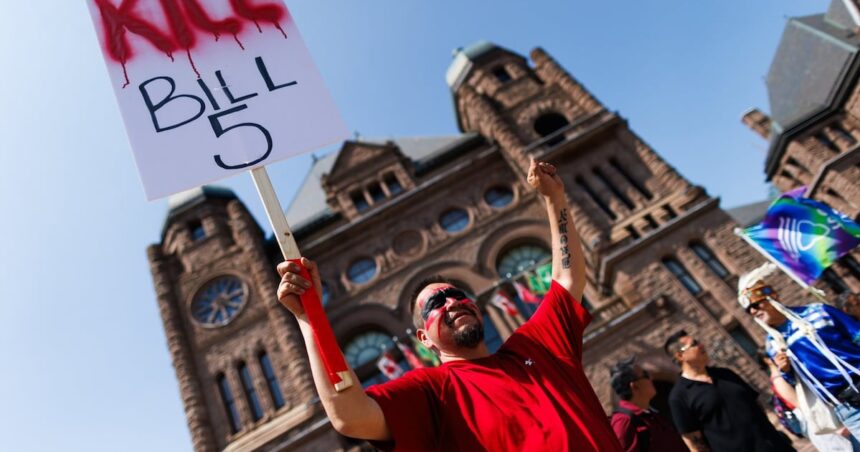Two First Nations actively working with Ontario on roads to the mineral-rich Ring of Fire region have voiced strong opposition to the province’s new mining legislation, saying it undermines Indigenous rights and ignores their concerns.
The Webequie and Marten Falls First Nations, who are leading environmental assessments for crucial access roads to the remote northern Ontario region, expressed profound disappointment with the Mining Amendment Act passed in early June. These communities find themselves in the uncomfortable position of cooperating with the Ford government on infrastructure while simultaneously fighting its mining policies.
“We’ve been clear with Ontario that this legislation doesn’t respect our role as stewards of our traditional territories,” said Chief Cornelius Wabasse of Webequie First Nation during a community meeting last week. “Working on road development doesn’t mean we’ve surrendered our rights to meaningful consultation on mining activities that will impact our lands for generations.”
The Ring of Fire, located approximately 500 kilometers northeast of Thunder Bay in Ontario’s Far North, contains significant deposits of chromite, nickel, copper, and platinum – critical minerals valued at an estimated $60 billion. The region has become the centerpiece of Premier Doug Ford’s northern development strategy, with the government promising thousands of jobs and economic prosperity.
According to documents obtained through freedom of information requests by the Yellowhead Institute, the Mining Amendment Act streamlines approval processes for mining companies while reducing requirements for Indigenous consultation. The legislation allows mining permits to be fast-tracked under certain conditions and limits the time frame for environmental reviews.
Bruce McIvor, a prominent Indigenous rights lawyer with First Peoples Law, told Mediawall.news that the legislation represents a troubling trend. “Ontario appears to be creating a two-track approach – publicly claiming to support reconciliation while passing laws that effectively diminish First Nations’ ability to protect their territories,” McIvor said.
For Marten Falls First Nation, which signed a memorandum of understanding with the province in 2020 regarding road development, the mining law creates additional strain on an already complex relationship. Chief Bruce Achneepineskum emphasized that their community’s participation in road planning doesn’t equate to blanket approval for mining operations.
“We agreed to work on access roads because our community needs infrastructure,” Achneepineskum explained during a recent CBC Radio interview. “But we’ve repeatedly told the province that mining development requires proper environmental protections and revenue-sharing agreements that reflect our inherent rights.”
The tensions highlight the challenging balancing act for First Nations seeking economic development while protecting traditional territories and rights. A recent Environics Institute survey found that 76% of Ontarians support increased Indigenous involvement in resource development decisions, suggesting public opinion may align more closely with First Nations’ positions than with provincial policy.
Ontario’s Minister of Mines George Pirie defended the legislation, stating in a press release that it “maintains strong environmental standards while creating certainty for investors.” However, when pressed by reporters about First Nations’ concerns at Queen’s Park last Thursday, Pirie acknowledged that “ongoing dialogue is needed” but declined to specify what changes the government might consider.
Environmental groups have joined First Nations in criticizing the mining law. Ontario Nature’s conservation director, Anne Bell, pointed out that the Ring of Fire region contains one of North America’s largest carbon-storing peatlands. “Rushing mining development without proper consultation not only violates Indigenous rights but risks releasing massive amounts of stored carbon at a time when we’re facing climate crisis,” Bell told Mediawall.news.
The political stakes are high for all parties. The Ford government has made the Ring of Fire central to its economic vision, even renaming the Ministry of Northern Development to include “Mines” in its title. For First Nations, the struggle represents both immediate concerns about environmental impacts and broader principles of self-determination.
Webequie and Marten Falls now find themselves walking a political tightrope – working with Ontario on roads they need for their communities while fighting legislation they see as threatening their territories. They’ve requested meetings with Premier Ford, so far without success.
“We’re not opposed to development that respects our rights and benefits our people,” Chief Wabasse emphasized. “But this mining law sends the wrong message about Ontario’s commitment to true partnership with First Nations.”
As federal Environment Minister Steven Guilbeault considers calls from some First Nations for a regional environmental assessment of the entire Ring of Fire region, the dispute illustrates the complex intersection of resource development, Indigenous rights, and environmental protection that continues to shape Canada’s political landscape.
For communities like Webequie and Marten Falls, the path forward remains uncertain. They’re proving that Indigenous nations can simultaneously work with governments on specific projects while standing firm against policies they believe undermine their rights – a nuanced position that challenges simplistic narratives about development in the North.






